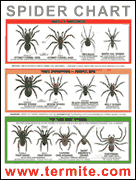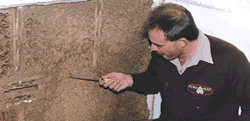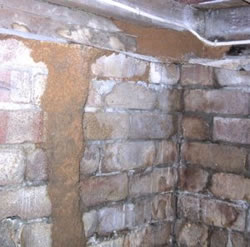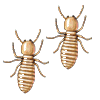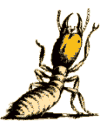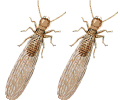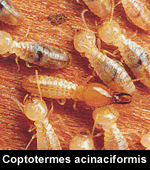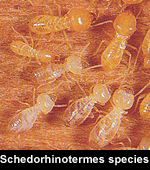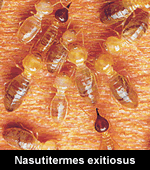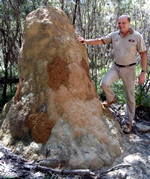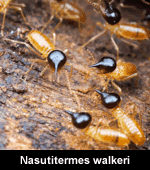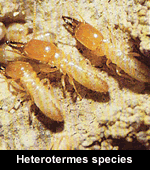|
|
Termites " white ants " in the Sydney, Central Coast & Illawarra regions
|
| |
Fumapest Termite & Pest Control ..... Since 1964
|
|
| |
Subterranean termites • White Ants |
|
| |
|
|
| |
Subterranean termites or "white-ants" are a highly destructive timber pest, causing major structural timber damage to both domestic and commercial buildings.
FUMAPEST Pest Control has more than 48 years practical experience in protecting buildings from termite infestations. For your protection phone 1300 241 500 to arrange for a thorough FUMAPEST inspection and report to Australian Standard 3660.
A major economic pest: Recent industry surveys suggest about one third of all unprotected properties in NSW are subject to attack by subterranean termites. Most of the latest technology for termite control products comes from the USA where termite control is a US$5 billion industry.
Most homes are at risk - particularly in built-up urban areas or where well established gum trees are within a 100 metre radius of the building.
The problem is getting worse: Severe termite damage to Australian homes is on the increase since the removal in 1995 of long lasting soil barrier chemicals; the more common use of softwood building and other landscaping timbers that termites find irresistible, such as, timber mulch and railway sleepers.
Other factors that promote rapid termite colony development - automatic watering systems - timber landscaping and maintenance - and building designs that allow hidden termite entry into a building.
DESTRUCTIVE TERMITE RISK ASSESSMENT *
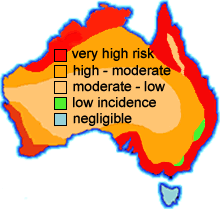 * Based upon CSIRO data and APCA national survey
* Based upon CSIRO data and APCA national survey
|
Termites live in the ground and can eat your house down
Termites are known to destroy the wall and roofing timbers of a home within 3 months of construction.
Termites cause more damage to homes in Australia than fire, floods, storms and tempest, combined.
Termites occur throughout NSW, with a high incidence of attack in virtually all urban areas.
CONSUMER NOTE: The standard Home and Building Insurance Policy will NOT cover the repair costs of termite infested structural and decorative timbers. |
Fascinating biology: Australian subterranean termites evolved more than 250 million year ago. They inhabited Australia long before flowering plants. Their survival success depends on living in a protective underground environment. In some species, their colony nest has a hardened shell, exposed above ground level. In most destructive species in NSW their nest is totally out of sight, below ground level.
Worker termites build mud-tubes over hard objects. The tubes or "galleries" are made up of partly digested timber and mud excrete, and is moist if currently in active use. The termites keep it's colony nest and galleries at 25 to 35oC with high humidity. If they are exposed to light or open air they will dehydrate and die. Subterranean termites live in constant darkness, excepting for the annual summer swarms of the winged reproductives to set up new nests in the surrounding area.
A million termites in the nest: In some destructive species, a termite colony nest may contain more than a million termites, consisting of a queen, king, young immature nymphs, workers, soldiers and winged reproductives (called alates). Termites are delicate, soft bodied and small in stature, about half the size of match-head, but are highly efficient timber recyclers - Mother Nature's best builders.
The worker termites are blind and forage in a largely random criss-cross fashion looking for new timber food sources. However, they may encounter and follow moisture zones and trail along solid objects, such as, the concrete slab edge of your home. The soldiers accompany the workers in their constant search for new timber food sources. If you find termites active in timber framing, it is the soldiers that rush out to defend the workers.
Experience counts: It takes many years of termite control field-work experience to get a proper understanding of the habits of the destructive termite species habits and their likely foraging areas in a variety of building types and environmental circumstances.
Look who's coming to dinner ... and whose home on the menu ?
Picture on your left shows a FUMAPEST termite inspector examining a large subsidiary nest, termites built inside the dining room wall cavity of a home.
Above ground nests Termites often build such above-ground nests provided there is a reliable moisture source, such as, from faulty plumbing, leaking pipes, shower recess, guttering, broken roof tiles and the like.
Mud shelter tubes - picture on left shows a termite mud shelter tube built over a brick foundation wall to the flooring timbers in the sub-floor of a home.
Termites are very secretive and will often enter a building through areas inaccessible to inspection, such as, via on-ground patios, cracks or expansion joints or around concrete slab flooring, particularly if the slab edge is obscured by pathways or garden beds.
Tiny entry points Termites can pass through a 2 mm crack in concrete slab on-ground flooring and eat through rubber compound between adjoining concrete slabs. Termites often travel under parquetry and other floor tiles to get to the wall and roofing framing timbers. |
|
|
| |
|
|
| |
The worker termites have a symbiotic digestive system |
|
| |
|
|
| |
Workers feed the colony: Only the worker termites can digest timber by use of symbiotic protozoa in their gut. The worker termites digest and then regurgitate the partly digested timber as a semi-liquid food for the other termite castes. Even the workers excrete is eaten by the other termites as it high in cellulose content. This feeding by mouth and anus is technically known as trophallaxis.
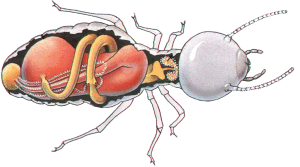 |
Modern termite control products take advantage of the mutual feeding and regular grooming habits of termites as a means to kill the entire colony.
Termite baits Workers termites readily ingest the bait and transfer it back to the colony nest to feed other termites. If sufficient workers ingest the bait and the queen is killed, then the collapse and death of the colony is highly likely. |
Cannibal like efficiency: Worker termites cannibalise other dead termites, which if they carry the bait in their system, will further hasten the demise of the colony.
Modern termite control products, preventive barriers, termite baiting and other recommendations are discussed in detail in the Termite Control section of this website. |
|
| |
|
|
| |
The biology and behaviour of Subterranean Termites |
|
| |
|
|
| |
 |
Ants vs Termites ... all out War for 250 million years
Termites live in underground nests and travel in mud tubes to protect them from their arch enemy...the ants. Termites descended from the cockroach family, whereas ants descended from the wasp family.
Ants will not protect you from termites: The soldier termites has a hard helmet-style head with large cutting pincers and a frontal pore to squirt sticky latex to ensnare the ants. |
Interdependent social structure: The termite colony has a king, queen, winged reproductive (young kings and queens), soldier and worker termites. Each has a different role to perform and all interdependent upon each other for survival of the colony.
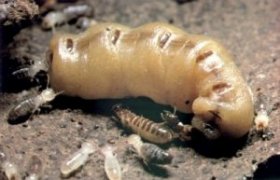
|
Picture of QUEEN and WORKER termites
|
|

|
WORKERS have thin delicate skin
|
|
Queen termite is an egg laying machine; her body is enormous compared to her off-spring; she can live more than 25 years and produce more that 2,000 eggs a day.
King termite stays by the side of the Queen all it's life locked away in the central nursery chamber tended to by worker termites, around the clock. |
Worker termites are most numerous in the termite colony. They are usually about 3 to 4 mm long, soft bodied, creamy translucent colour, have no wings, are sterile and blind.
Busy 24/7 Worker termites carry out all work in the nest, including food gathering, building, repairing and maintaining the colony nest structure and foraging tunnel system.
Only the workers can digest timber which they regurgitate and feed in liquid form to the queen and other termites in the colony. |
Soldier termites commonly have an orange coloured armored head
with mandibulate pinchers which they use to crush an attacker, such as ants; some have hard pointed snout which eject a white sticky latex to ensnare their enemies.
Soldier termites are often seen in large numbers when an active shelter tubes or damaged timber, is opened. Soldier termites will rush out to guard the opening whilst worker termites repair the breach. |
Alates or winged reproductives
are commonly seen when they swarm on a hot humid summer evening around dusk, often in their thousands from a large mature colony nest. Unlike the other caste, they have eyes but are , are poor fliers. The hover and are swept along by prevailing winds.
The swarmers when they land, they drop their wings, and use a pheromone chemical signal attract a mate to start up a new colony of termites.
Consumer note: If you find swarming termites, it is a sure DANGER sign that a large termite colony nest is close-by, and your home is at high risk of a severe termite infestation. Is so, you should contact us to immediately to assess the situation. |
|
|
| |
|
|
| |
The life-cycle of Subterranean Termites |
|
| |
|
|
| |
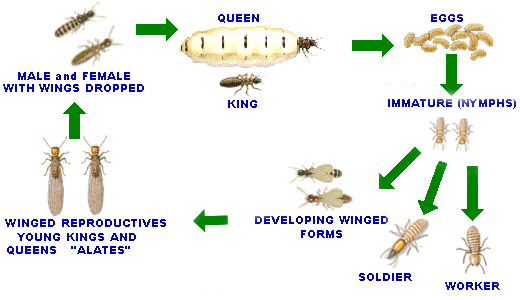
Termites constantly groom and feed each other. A valuable technique for the termite controller is to install and monitor a termite baiting system next to any live activity found in and around the premises where termite foraging is most likely to occur. Subsequent regular inspections indicate the amount of bait consumed and the condition of any termites observed. They may appear sick, exhibit a change of colour to a mottle look, indicating the effect of the termite bait over time.
Nemesis termite bait is formulated as an attractive food source to the termites. The bait has a delayed lethal effect. Time enough to be transferred to other termites in the colony nest. If the queen is killed, the nest goes into rapid decline leading to the elimination of the entire colony. This process is explained in detail in the Termite Control section of this website. |
|
| |
|
|
| |
The main destructive species of termites |
|
| |
|
|
| |
Proper identification is essential: Some species of subterranean termites prefer to attack living trees and will not eat dry seasoned timbers in a building, whilst others can be are highly destructive to such buildings in a short amount of time. Listed below are some important destructive termite species.
| Coptotermes acinaciformis |
Commonly found - particularly in urban areas - under concrete on-ground flooring and in areas where eucalypt gum trees are highly prevalent.
Destructive Nature - Coptotermes acinaciformis are highly destructive to buildings and other timber structures. The most widely distributed and destructive timber pest in the region - accounting for more than 70% of the serious damage to buildings. A single colony may consist of more than one million termites. A most voracious timber pest ... one to be taken seriously.
Nest Location - Coptotermes acinaciformis - very secretive termite species; they build their nest out of sight, often within the base of eucalyptus or other susceptible trees, or completely under the ground; often within an enclosed patio or under concrete on ground flooring which is ideal for moisture retention, temperature and humidity control within the termite colony's central nest.
Coptotermes acinaciformis can also construct subsidiary termite nests away from the main colony nest. A subsidiary White-ant nest can be contained in a wall cavity of a building where there is a reliable moisture source, for example, from a leaking shower recess or faulty guttering or rusted down pipes.
| Schedorhinotermes intermedius |
Area of Distribution - Commonly found in eastern NSW - along the Great Dividing Range and adjoining slopes.
Identification - these termites "gouge" the affected timber - has a fetish around nails used in construction. When you first find them, you will often see a major soldier (6mm in body length) and a minor soldier (4mm in body length).
Destructive Nature - Schedorhinotermes intermedius are highly destructive to buildings and other timber structures. If mostly major (larger) soldiers are sighted, it is most likely a large colony with the potential to cause severe and rapid damage to structural timbers of a building or other timber structures.
Nest Location - Schedorhinotermes intermedius commonly build their nest in tree stumps, in the root crown of the living, dead and debilitated trees, under houses or within enclosed patios or other areas where timber has been buried or stored in contact with the soil.
Area of Distribution - Commonly found - particularly in urban areas, where buildings are constructed of softwood or oregon timber framing.
Destructive Nature - Coptotermes frenchi can cause severe damage to buildings and other wooden structures. It is common for this species to devour timber framing leaving only a thin veneer. This species is the most shy of the destructive species; they will retreat from a location immediately (for the time being) if disturbed.
Nest Location - Coptotermes frenchi most often build their nest in the root crown or lower trunk area of living trees, particularly eucalypts. They may also build their nest as a mound in the dryer areas.
Area of Distribution - Commonly found throughout NSW - particularly in urban areas or where eucalypt gum trees are highly prevalent.
Destructive Nature - Nasutitermes exitiosus are destructive to buildings and other timber structures. Sometimes severe damage may occur, but not so commonly as the other species listed above.
Nest Location - Nasutitermes exitiosus build a mound nest which protrudes 30cm to 75cm above the ground. Control can be as easy as knocking the top off the nest and a follow up insecticide treatment inside the nest.
Area of Distribution - Commonly found in eastern NSW - particularly prevalent along the entire coast-line, along the Great Dividing Range and western slopes.
Destructive Nature - Coptotermes lacteus attacks stumps, dead trees, timber fences, poles and other timber structures that are in contact with the soil, being softened by weathering or decay. These termites are also known to attack such timber in damp sub-floor areas.
Nest Location - this termite species, most often builds it's nest as a mound up to 2m above ground level, with hard clay walls, so control is easily effected once located by knocking the top off and insecticide treatment of the nest.
Area of Distribution - Commonly found in eastern NSW - particularly prevalent in the coastal and mountain regions along the entire eastern side of NSW.
Destructive Nature - Nasutitermes walkeri can be destructive to damp timbers often a serious problem where the sub-floor of a building is damp and ventilation is poor with resulting wood decay or fungal growth.
Nest Location - Nasutitermes walkeri build their nest in trees on the main trunk or in the fork of a large branch.
Area of Distribution - Commonly found throughout NSW - particularly in urban areas or where eucalypt gum trees are highly prevalent.
Destructive Nature - Heterotermes ferox prefer damp timbers, fences and poles with wood decay. Often confused with the more destructive Coptotermes acinaciformis species. Correct identification is essential.
Nest Location - Heterotermes ferox often build their colony nest next to stumps, logs, or other timber in direct contact with the soil where some wood decay or rotting is prevalent.
Dampwood termites form small independent nests which often attack sick or dead trees, decaying stumps or mould timber in the ground; they are seldom found in dry timbers in buildings.
Drywood termites occur mostly in tropical areas, where the atmospheric humidity is constantly above 75 percent. The introduced and highly destructive West Indian drywood termite, Cryptotermes brevis, is rarely located in NSW, once in Sydney in the early 1980's. Specialist eradication procedures involve wrapping the entire building in plastic and using methyl bromide fumigation. |
|
| |
|
|
| |
If You find termites ... do NOT disturb them |
|
| |
|
|
| |
Termites have acute survival instincts. If shaken up or disturbed, the termites will abandon the area and move other areas in the building. If you find termites in or around your property, it is essential that you do NOT disturb them and promptly arrange for a professional FUMAPEST inspection and application of a termite bait to the live termites, if present in abundance.
 |
|
Subterranean Termites
Mother Nature's most prolific builders
This picture shows a large above ground termite nest found in the Northern Territory of Australia.
In cooler climates, most of the destructive termite species build their nest completely below ground level.
A large colony in the [town] urban environment is most often unseen, being totally below ground level with a nest containing more than a million termites looking for and devouring timber structures in their path leaving only an thin empty shell.
FUMAPEST Pest Control has more than 48 years practical experience in protecting buildings from termite infestations.
For your protection phone 1300 241 500 to arrange for a FUMAPEST inspection and report to Australian Standard 3660. |
|
|
|
| |
|
|
|
FUMAPEST Spider Identification Chart
|
|
|
For information on pest control - click on your problem pest
|
|
|

